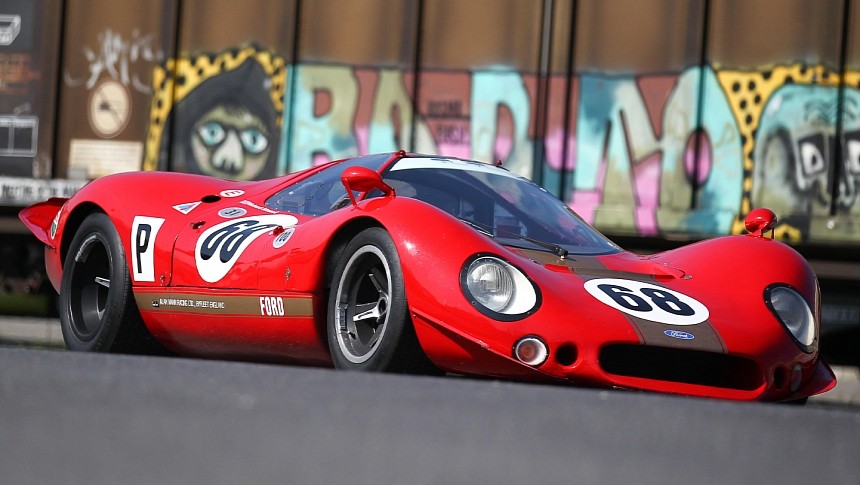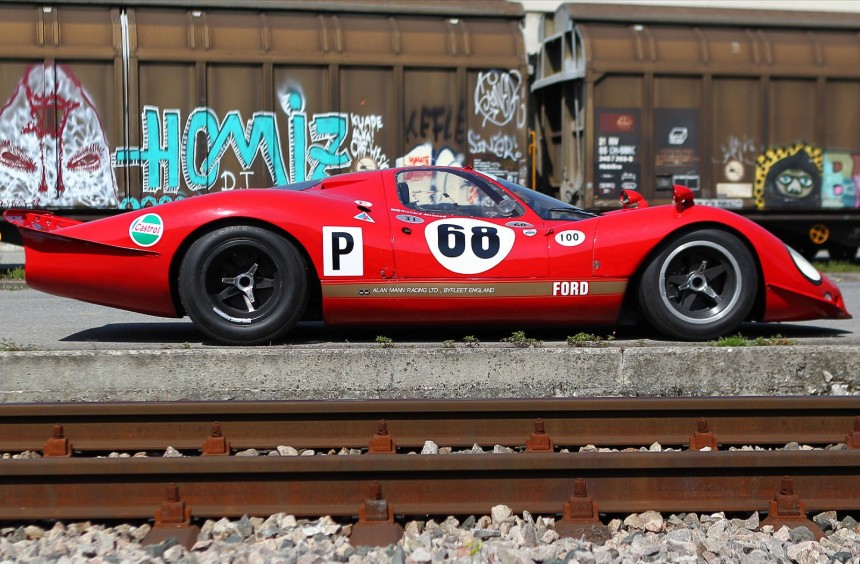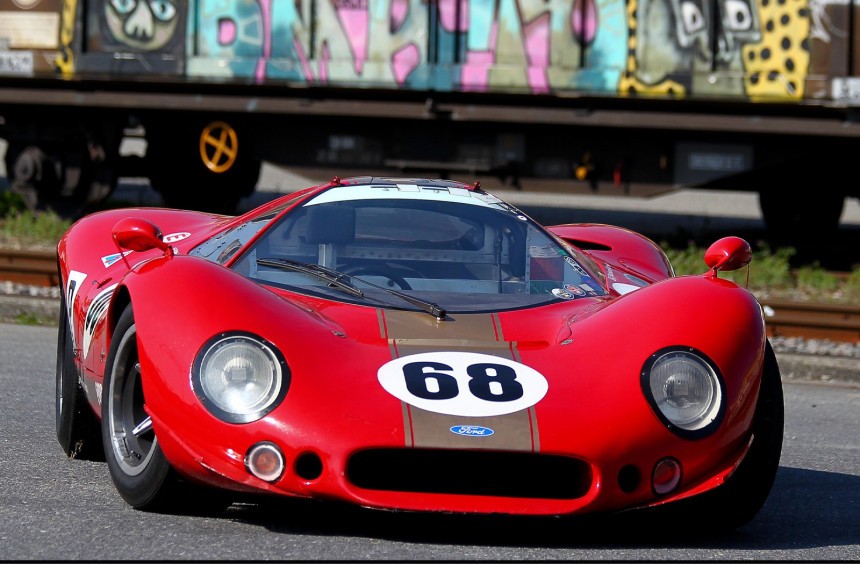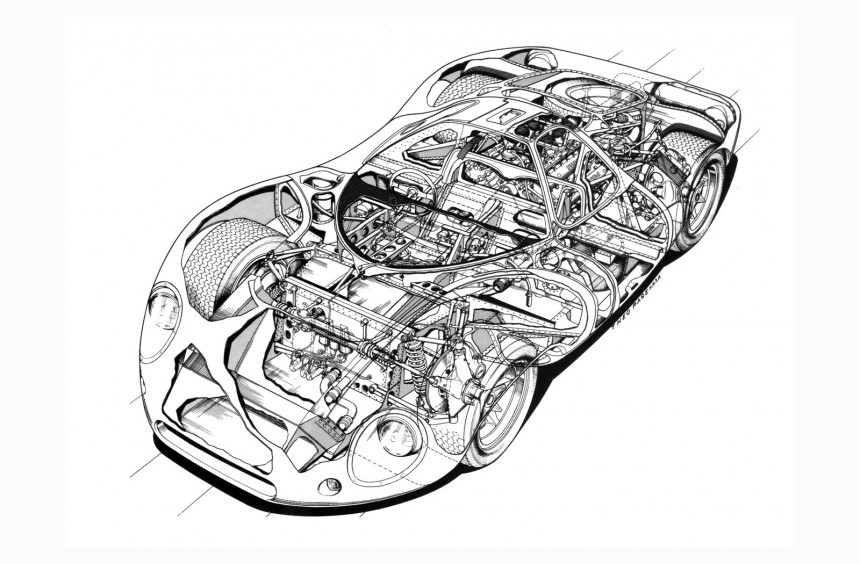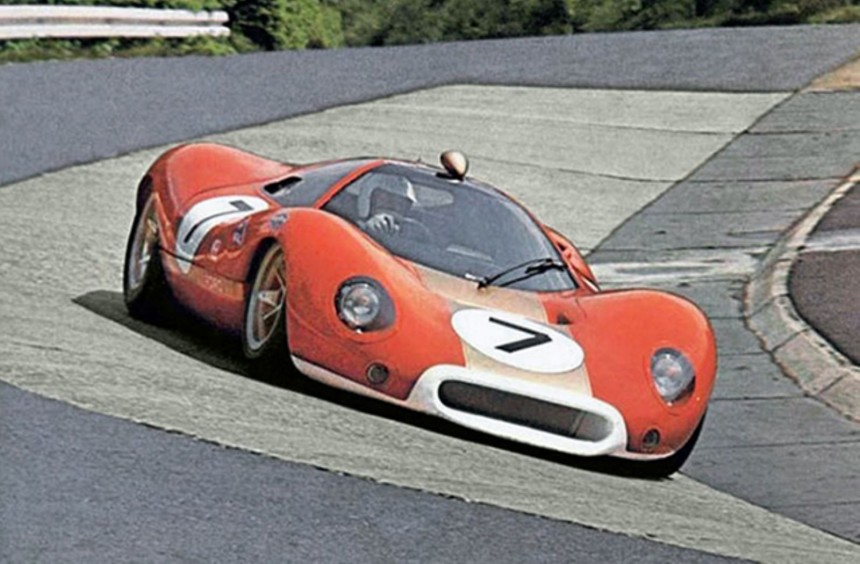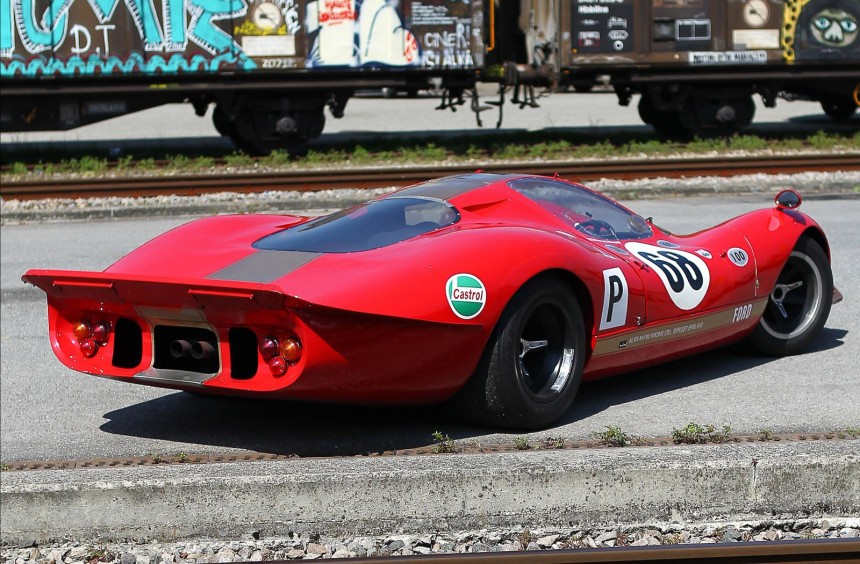Ford officially withdrew from endurance racing after ending Ferrari's dominance at the 24-Hours of Le Mans by winning the legendary race two times in a row. However, its British division wanted to keep going and developed an all-new prototype.
The famous Ford vs. Ferrari rivalry started in the early 1960s with the Blue Oval's unsuccessful attempt to purchase the Italian sports car manufacturer.
Enraged by Enzo Ferrari's mind games and the failure to strike an agreement, the American corporation's boss, Henry Ford II, diverted a massive amount of resources to create a race car that would end Ferrari's dominance at the world's most famous race.
In what became motorsport's biggest 'f-you" moment, Ford pulled off a 1-2-3 win at Le Mans in 1966 with its impressive GT40 Mk II. A year later, the revised Mk IV returned to France and kicked the Italians' behind again, adding insult to injury.
While the Americans were celebrating their epic achievement and Ferrari was hard at work to develop a GT40 killer, the Fédération Internationale de l'Automobile (FIA) decided to profoundly alter the World Sports Car Championship (which the Le Mans race was part of) rulebook for the upcoming season without consulting with any of the manufacturers.
The new rules stated that the engine displacement for the top Group 6 Prototypes class would be limited to three liters instead of five. Still, prototypes equipped with 5.0-liter engines would be allowed to compete in the Group 4 Sports Car class, but to gain homologation, manufacturers had to build a minimum of 50 identical chassis.
FIA's shocking decision made Ford's Mk IV GT40 and its main rival, the Ferrari 330 P4, obsolete since neither carmaker could meet the 50-unit homologation criteria. Therefore, both Ford and Ferrari retired their factory teams from the competition.
Despite the American corporation's decision, its UK division started its own Group 6 project (albeit with only a fraction of the GT40's budget), determined to continue where the Mk IV left off.
Back then, the division had spent a lot of money on developing the 3.0-liter Cosworth DPV Formula 1 engine that debuted in the third race of the 1967 season. Not only was management confident that the motor would dominate the world's premier open-wheel competition (which proved an accurate assessment), but they also thought that, mounted on the proper chassis, the V8 could be successful in Group 6 prototype racing.
Therefore, the task of creating a winning chassis was handed down to Alan Mann Racing (AMR), who was no stranger to endurance racing, having been a factory-backed Ford team that raced and developed their own versions of the GT40 since 1964.
The dry-sumped, all-aluminum DOHC 32-valve Cosworth DPV V8, which was slightly modified for the rigors of endurance racing, had an output rating of 420hp at 9000 rpm and 270 lb-ft (366 Nm) at 7000 rpm. Mounted in the middle of the new chassis, the powerplant was linked to a Hewland DG300 five-speed manual instead of the ZF 5DS gearbox in the Lotus Type 49 Formula 1 car.
Apart from the Formula 1 engine, the new Group 6 prototype - dubbed Ford P68 but commonly referred to as Ford 3L GT or F3L - was built around a bespoke chassis heavily inspired by the open-wheel race cars of the era.
Designed in AMR's Weybridge, Surrey-based workshop by GT40 veteran Len Bailey, the structure was a lightweight aluminum monocoque with a fully independent suspension that featured a traditional double-wishbone layout at the front and inverted lower wishbones with single top links and twin trailing arms at the rear.
The disc brakes hidden behind the alloy center-lock wheels were supplied by Girling and were mounted within the cast magnesium uprights to optimize cooling.
Essentially a two-seat Formula 1 chassis, it was covered with a long, low-slung, and curvy aluminum body that made the P68 look more like Ferrari's P3 prototypes than its indirect, Le Mans-winning predecessor.
During initial tests, the P68, with its aerodynamically-efficient body and Formula 1 engine, proved extremely fast. It could reach speeds of around 217 mph (350 kph) with relative ease, which made it faster than a contemporary Formula 1 car.
Despite this, the experienced drivers who got behind the wheel reported severe stability issues at high speeds. Moreover, Frank Gardner, AMR's top driver, felt the cockpit was too cramped, so a second, revised chassis with a slightly longer wheelbase was built especially for him. AMR also built a third car that debuted several weeks later without being adequately tested.
With extensive aerodynamic enhancements, two P68s debuted at Brands Hatch on April 7, 1968. One car was co-driven by Le Mans winner Bruce McLaren and reigning Formula 1 champion Denny Hulme, while the other was shared by Jochen Rindt (another Le Mans winner) and Mike Spence.
Despite the many improvements and all-star driver lineup, one P68 failed to qualify due to an engine mount failure, while the other made it to the race but had to retire while in the lead due to transmission issues.
Unfortunately for the Ford UK/AMR partnership, the P68 continued to be plagued by a multitude of mechanical problems during the following races it competed in. By the end of the 1968 season, none of the P68s managed to finish a single race. Even more disastrous, the nightmare continued during the 1969 season when the P68 was campaigned along its improved, open-top P69 sibling.
With funds running out, Ford UK eventually pulled the plug on both the P68 and P69 projects after not being able to finish a single race with any of the cars and failing to compete at Le Mans.
Meanwhile, thanks to John Wyer's efforts to homologate several 4.9-liter V8-powered GT40 Mk I chassis for the Group 4 Sports Car class, Ford added two more Le Mans victories to its resume in 1968 and 1969.
Today, it's believed that only two of the three P68 chassis have survived. The chassis featured in this article (no. 002) was auctioned off by Bonhams in 2018, fetching £511,750 ($664,996).
Though it was a failure of epic proportions for both Ford UK and Alan Mann Racing, it remains a fascinating race car. A gorgeous and unique blend between a Formula 1 car and a Group 6 prototype, it could have risen to the heights of the GT40 had it benefitted from the same budget.
In the YouTube video below by Retroschaft you can see the P68 (and hear its legendary V8) compete during the 2016 Spa Classic in Belgium.
Enraged by Enzo Ferrari's mind games and the failure to strike an agreement, the American corporation's boss, Henry Ford II, diverted a massive amount of resources to create a race car that would end Ferrari's dominance at the world's most famous race.
In what became motorsport's biggest 'f-you" moment, Ford pulled off a 1-2-3 win at Le Mans in 1966 with its impressive GT40 Mk II. A year later, the revised Mk IV returned to France and kicked the Italians' behind again, adding insult to injury.
FIA's controversial rule change
The new rules stated that the engine displacement for the top Group 6 Prototypes class would be limited to three liters instead of five. Still, prototypes equipped with 5.0-liter engines would be allowed to compete in the Group 4 Sports Car class, but to gain homologation, manufacturers had to build a minimum of 50 identical chassis.
FIA's shocking decision made Ford's Mk IV GT40 and its main rival, the Ferrari 330 P4, obsolete since neither carmaker could meet the 50-unit homologation criteria. Therefore, both Ford and Ferrari retired their factory teams from the competition.
Ford Europe's Group 6 challenger
Back then, the division had spent a lot of money on developing the 3.0-liter Cosworth DPV Formula 1 engine that debuted in the third race of the 1967 season. Not only was management confident that the motor would dominate the world's premier open-wheel competition (which proved an accurate assessment), but they also thought that, mounted on the proper chassis, the V8 could be successful in Group 6 prototype racing.
Therefore, the task of creating a winning chassis was handed down to Alan Mann Racing (AMR), who was no stranger to endurance racing, having been a factory-backed Ford team that raced and developed their own versions of the GT40 since 1964.
A two-seat Formula 1 car with a Group 6 body
Apart from the Formula 1 engine, the new Group 6 prototype - dubbed Ford P68 but commonly referred to as Ford 3L GT or F3L - was built around a bespoke chassis heavily inspired by the open-wheel race cars of the era.
Designed in AMR's Weybridge, Surrey-based workshop by GT40 veteran Len Bailey, the structure was a lightweight aluminum monocoque with a fully independent suspension that featured a traditional double-wishbone layout at the front and inverted lower wishbones with single top links and twin trailing arms at the rear.
The disc brakes hidden behind the alloy center-lock wheels were supplied by Girling and were mounted within the cast magnesium uprights to optimize cooling.
Essentially a two-seat Formula 1 chassis, it was covered with a long, low-slung, and curvy aluminum body that made the P68 look more like Ferrari's P3 prototypes than its indirect, Le Mans-winning predecessor.
A disastrous season
Despite this, the experienced drivers who got behind the wheel reported severe stability issues at high speeds. Moreover, Frank Gardner, AMR's top driver, felt the cockpit was too cramped, so a second, revised chassis with a slightly longer wheelbase was built especially for him. AMR also built a third car that debuted several weeks later without being adequately tested.
With extensive aerodynamic enhancements, two P68s debuted at Brands Hatch on April 7, 1968. One car was co-driven by Le Mans winner Bruce McLaren and reigning Formula 1 champion Denny Hulme, while the other was shared by Jochen Rindt (another Le Mans winner) and Mike Spence.
Despite the many improvements and all-star driver lineup, one P68 failed to qualify due to an engine mount failure, while the other made it to the race but had to retire while in the lead due to transmission issues.
Unfortunately for the Ford UK/AMR partnership, the P68 continued to be plagued by a multitude of mechanical problems during the following races it competed in. By the end of the 1968 season, none of the P68s managed to finish a single race. Even more disastrous, the nightmare continued during the 1969 season when the P68 was campaigned along its improved, open-top P69 sibling.
A failure of epic proportions
Meanwhile, thanks to John Wyer's efforts to homologate several 4.9-liter V8-powered GT40 Mk I chassis for the Group 4 Sports Car class, Ford added two more Le Mans victories to its resume in 1968 and 1969.
Today, it's believed that only two of the three P68 chassis have survived. The chassis featured in this article (no. 002) was auctioned off by Bonhams in 2018, fetching £511,750 ($664,996).
Though it was a failure of epic proportions for both Ford UK and Alan Mann Racing, it remains a fascinating race car. A gorgeous and unique blend between a Formula 1 car and a Group 6 prototype, it could have risen to the heights of the GT40 had it benefitted from the same budget.
In the YouTube video below by Retroschaft you can see the P68 (and hear its legendary V8) compete during the 2016 Spa Classic in Belgium.
